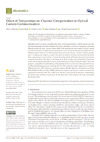Identificador persistente para citar o vincular este elemento:
https://accedacris.ulpgc.es/jspui/handle/10553/77395
| Título: | Effect of temperature on channel compensation in optical camera communication | Autores/as: | Moreno, Daniel Rufo, Julio Guerra, Víctor Rabadán, José Pérez-Jiménez, Rafael |
Clasificación UNESCO: | 3307 Tecnología electrónica | Palabras clave: | Channel Compensation Led Optical Camera Communication Spectrum Channel compensation |
Fecha de publicación: | 2021 | Publicación seriada: | Electronics (Switzerland) | Resumen: | General-purpose Complementary Metal Oxide Semiconductor (CMOS) sensors perform the image desegregation in three channels (red, green, and blue) as a result of a band-pass wavelength filtering carried out using Foveon or Bayer filters. This characteristic can be used in Optical Camera Communication (OCC) systems for increasing the links’ data rate by introducing Wavelength Division Multiplexing (WDM) or Color Shift Keying (CSK) modulation schemes. However, these techniques need a compensation stage to mitigate the cross-talk between channels introduced by the filters. This compensation is performed by a Channel State Information (CSI) estimation and a zero-forcing compensation scheme. The impact of the temperature effects of light-emitting diode (LED) emissions on the zero-forcing compensation scheme’s performance has not been analyzed in depth. This work presents a comprehensive methodology and experimental characterization of this impact for Foveon and Bayer-based image sensors, assuming that the CSI is estimated under temperature conditions different from the LED’s stationary temperature regime. Besides, Signal-to-Interference-plus-Noise Ratio (SINR) and Bit Error Rate (BER) performance metrics are presented in order to estimate the repercussion in an OCC link. The results reveal that the Foveon sensor obtains more unsatisfactory performance than the Bayer-based sensor. On the other hand, the blue band is the most penalized by the thermal effect. | URI: | https://accedacris.ulpgc.es/handle/10553/77398 | ISSN: | 2079-9292 | DOI: | 10.3390/electronics10030262 | Fuente: | Electronics (Switzerland)[EISSN 2079-9292],v. 10 (3), p. 1-20, (Enero 2021) |
| Colección: | Artículos |
Citas SCOPUSTM
10
actualizado el 08-jun-2025
Citas de WEB OF SCIENCETM
Citations
9
actualizado el 08-jun-2025
Visitas
108
actualizado el 02-sep-2023
Descargas
98
actualizado el 02-sep-2023
Google ScholarTM
Verifica
Altmetric
Comparte
Exporta metadatos
Los elementos en ULPGC accedaCRIS están protegidos por derechos de autor con todos los derechos reservados, a menos que se indique lo contrario.
